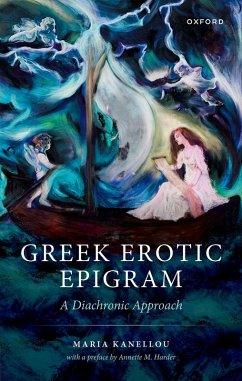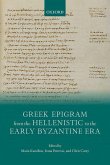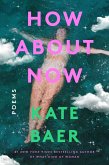Andere Kunden interessierten sich auch für
![Greek Epigram from the Hellenistic to the Early Byzantine Era Greek Epigram from the Hellenistic to the Early Byzantine Era]() Greek Epigram from the Hellenistic to the Early Byzantine Era157,99 €
Greek Epigram from the Hellenistic to the Early Byzantine Era157,99 €![An Alexandrian Erotic Fragment and Other Greek Papyri, Chiefly Ptolemaic (1896) An Alexandrian Erotic Fragment and Other Greek Papyri, Chiefly Ptolemaic (1896)]() An Alexandrian Erotic Fragment and Other Greek Papyri, Chiefly Ptolemaic (1896)22,99 €
An Alexandrian Erotic Fragment and Other Greek Papyri, Chiefly Ptolemaic (1896)22,99 €![Erotic Subjects Erotic Subjects]() Melissa E. SanchezErotic Subjects54,99 €
Melissa E. SanchezErotic Subjects54,99 €![Matters Of The Heart Matters Of The Heart]() Kwajelyn LewisMatters Of The Heart16,99 €
Kwajelyn LewisMatters Of The Heart16,99 €![Erotic & Romantic Poetry 2 Erotic & Romantic Poetry 2]() Lyrical PoetErotic & Romantic Poetry 215,99 €
Lyrical PoetErotic & Romantic Poetry 215,99 €![How about Now How about Now]() Kate BaerHow about Now21,99 €
Kate BaerHow about Now21,99 €![Flowers of Evil (Les Fleurs du Mal) Flowers of Evil (Les Fleurs du Mal)]() Charles BaudelaireFlowers of Evil (Les Fleurs du Mal)19,99 €
Charles BaudelaireFlowers of Evil (Les Fleurs du Mal)19,99 €-
Produktdetails
- Verlag: Oxford University Press
- Seitenzahl: 336
- Erscheinungstermin: 30. April 2025
- Englisch
- Abmessung: 218mm x 144mm x 28mm
- Gewicht: 538g
- ISBN-13: 9780198816140
- ISBN-10: 0198816146
- Artikelnr.: 73480465
- Herstellerkennzeichnung
- Libri GmbH
- Europaallee 1
- 36244 Bad Hersfeld
- gpsr@libri.de
* Preface
* Acknowledgments
* List of Abbreviations
* Introduction
* 1. Why Write a Book on the Diachronic Study of Erotic Epigram?
* 2. The Contents of the Book
* 1: The Lamp as a Vehicle for Exploring the Lover's Emotions
* 1. First Appearances of the Lamp Motif in Asclepiades
* 2. The Development of the Motif in the Meleagrian Epigrams
* 3. Outside the Melegrian Garland: Philodemus and Statyllius Flaccus
* 4. Marcus Argentarius and the Lamp's Prophetic Abilities
* 5. The Survival of the Lamp in the Cycle of Agathias
* 6. Conclusions
* 2: Unboxing Sea and Nautical Metaphors
* 1.1 The Ship-Prostitute Epigrams and Their Intertextual Background
* 1.2 Alcaeus and the Ship-Prostitute
* 1.3 Theognis and Aristophanes: Ship Imagery and the Ambiguities of
Control
* 2.1 The Ship-Prostitute in Epigram: Hetaerae Described as Ships
* 2.2 Ships Described in Language Applicable to Hetaerae
* 3.1 Hellenistic Epigram and the Sea of Love
* 3.2 The Heterosexual Epigrams
* 3.3 The Homoerotic Epigrams
* 4.1 The Survival of Sea and Nautical Metaphors after Meleager's
Garland
* 4.2 Sea Metaphors in Their Sexual Form: The Case Study of Automedon
AP 11.29
* 4.3 Further Examples of Sexual Sea Metaphors: The Anonymous AP
11.220 and Rufinus AP 5.35
* 4.4 The Sea of Love in Macedonius Consul AP 5.235
* 5. Conclusions
* 3: Comparing the Beloved with the Supreme Goddess of Beauty
* 1. The Beloved's Praise in the Poetic Tradition: The Limitations of
Hyperbole
* 2. Implied Comparison with Aphrodite: Nossis' Dedicatory Epigrams
* 3. Hellenistic Queens and Aphrodite: Three Posidippean Epigrams and
Asclepiades or Posidippus APl (A) 68
* 4. Asclepiades or Posidippus AP 5.194: Indirect Links Between a
Non-Royal Woman and Aphrodite
* 5.1 Antipater of Sidon: Staying within Limits (AP 9.567 and 7.14)
* 5.2 Antipater of Sidon: Stretching the Boundaries (AP 7.218)
* 6. The 'Apotheosis' of the Motif in the Meleagrian Epigrams
* 7. Comparing the Male Beloved with Eros
* 8.1 The Motif after Meleager: Marcus Argentarius and Rufinus
* 8.2 The Motif in the Cycle of Agathias
* 9. Conclusions
* 4: Eros and the Erotes: The Tormentors of Humans
* 1.1 Eros' Disguises: Recollections of Lyric Poetry
* 1.2 Eros the Crawling Creature
* 2. Amalgamation of Different Portrayals of Eros in the Same Epigram
* 3.1 From the Single Eros to the Erotes: The Motif's Literary Roots
* 3.2 Multiple Erotes for Multiple Effects
* 4. Conclusions
* Epilogue
* Bibliography
* General Index
* Index Locorum
* Acknowledgments
* List of Abbreviations
* Introduction
* 1. Why Write a Book on the Diachronic Study of Erotic Epigram?
* 2. The Contents of the Book
* 1: The Lamp as a Vehicle for Exploring the Lover's Emotions
* 1. First Appearances of the Lamp Motif in Asclepiades
* 2. The Development of the Motif in the Meleagrian Epigrams
* 3. Outside the Melegrian Garland: Philodemus and Statyllius Flaccus
* 4. Marcus Argentarius and the Lamp's Prophetic Abilities
* 5. The Survival of the Lamp in the Cycle of Agathias
* 6. Conclusions
* 2: Unboxing Sea and Nautical Metaphors
* 1.1 The Ship-Prostitute Epigrams and Their Intertextual Background
* 1.2 Alcaeus and the Ship-Prostitute
* 1.3 Theognis and Aristophanes: Ship Imagery and the Ambiguities of
Control
* 2.1 The Ship-Prostitute in Epigram: Hetaerae Described as Ships
* 2.2 Ships Described in Language Applicable to Hetaerae
* 3.1 Hellenistic Epigram and the Sea of Love
* 3.2 The Heterosexual Epigrams
* 3.3 The Homoerotic Epigrams
* 4.1 The Survival of Sea and Nautical Metaphors after Meleager's
Garland
* 4.2 Sea Metaphors in Their Sexual Form: The Case Study of Automedon
AP 11.29
* 4.3 Further Examples of Sexual Sea Metaphors: The Anonymous AP
11.220 and Rufinus AP 5.35
* 4.4 The Sea of Love in Macedonius Consul AP 5.235
* 5. Conclusions
* 3: Comparing the Beloved with the Supreme Goddess of Beauty
* 1. The Beloved's Praise in the Poetic Tradition: The Limitations of
Hyperbole
* 2. Implied Comparison with Aphrodite: Nossis' Dedicatory Epigrams
* 3. Hellenistic Queens and Aphrodite: Three Posidippean Epigrams and
Asclepiades or Posidippus APl (A) 68
* 4. Asclepiades or Posidippus AP 5.194: Indirect Links Between a
Non-Royal Woman and Aphrodite
* 5.1 Antipater of Sidon: Staying within Limits (AP 9.567 and 7.14)
* 5.2 Antipater of Sidon: Stretching the Boundaries (AP 7.218)
* 6. The 'Apotheosis' of the Motif in the Meleagrian Epigrams
* 7. Comparing the Male Beloved with Eros
* 8.1 The Motif after Meleager: Marcus Argentarius and Rufinus
* 8.2 The Motif in the Cycle of Agathias
* 9. Conclusions
* 4: Eros and the Erotes: The Tormentors of Humans
* 1.1 Eros' Disguises: Recollections of Lyric Poetry
* 1.2 Eros the Crawling Creature
* 2. Amalgamation of Different Portrayals of Eros in the Same Epigram
* 3.1 From the Single Eros to the Erotes: The Motif's Literary Roots
* 3.2 Multiple Erotes for Multiple Effects
* 4. Conclusions
* Epilogue
* Bibliography
* General Index
* Index Locorum
* Preface
* Acknowledgments
* List of Abbreviations
* Introduction
* 1. Why Write a Book on the Diachronic Study of Erotic Epigram?
* 2. The Contents of the Book
* 1: The Lamp as a Vehicle for Exploring the Lover's Emotions
* 1. First Appearances of the Lamp Motif in Asclepiades
* 2. The Development of the Motif in the Meleagrian Epigrams
* 3. Outside the Melegrian Garland: Philodemus and Statyllius Flaccus
* 4. Marcus Argentarius and the Lamp's Prophetic Abilities
* 5. The Survival of the Lamp in the Cycle of Agathias
* 6. Conclusions
* 2: Unboxing Sea and Nautical Metaphors
* 1.1 The Ship-Prostitute Epigrams and Their Intertextual Background
* 1.2 Alcaeus and the Ship-Prostitute
* 1.3 Theognis and Aristophanes: Ship Imagery and the Ambiguities of
Control
* 2.1 The Ship-Prostitute in Epigram: Hetaerae Described as Ships
* 2.2 Ships Described in Language Applicable to Hetaerae
* 3.1 Hellenistic Epigram and the Sea of Love
* 3.2 The Heterosexual Epigrams
* 3.3 The Homoerotic Epigrams
* 4.1 The Survival of Sea and Nautical Metaphors after Meleager's
Garland
* 4.2 Sea Metaphors in Their Sexual Form: The Case Study of Automedon
AP 11.29
* 4.3 Further Examples of Sexual Sea Metaphors: The Anonymous AP
11.220 and Rufinus AP 5.35
* 4.4 The Sea of Love in Macedonius Consul AP 5.235
* 5. Conclusions
* 3: Comparing the Beloved with the Supreme Goddess of Beauty
* 1. The Beloved's Praise in the Poetic Tradition: The Limitations of
Hyperbole
* 2. Implied Comparison with Aphrodite: Nossis' Dedicatory Epigrams
* 3. Hellenistic Queens and Aphrodite: Three Posidippean Epigrams and
Asclepiades or Posidippus APl (A) 68
* 4. Asclepiades or Posidippus AP 5.194: Indirect Links Between a
Non-Royal Woman and Aphrodite
* 5.1 Antipater of Sidon: Staying within Limits (AP 9.567 and 7.14)
* 5.2 Antipater of Sidon: Stretching the Boundaries (AP 7.218)
* 6. The 'Apotheosis' of the Motif in the Meleagrian Epigrams
* 7. Comparing the Male Beloved with Eros
* 8.1 The Motif after Meleager: Marcus Argentarius and Rufinus
* 8.2 The Motif in the Cycle of Agathias
* 9. Conclusions
* 4: Eros and the Erotes: The Tormentors of Humans
* 1.1 Eros' Disguises: Recollections of Lyric Poetry
* 1.2 Eros the Crawling Creature
* 2. Amalgamation of Different Portrayals of Eros in the Same Epigram
* 3.1 From the Single Eros to the Erotes: The Motif's Literary Roots
* 3.2 Multiple Erotes for Multiple Effects
* 4. Conclusions
* Epilogue
* Bibliography
* General Index
* Index Locorum
* Acknowledgments
* List of Abbreviations
* Introduction
* 1. Why Write a Book on the Diachronic Study of Erotic Epigram?
* 2. The Contents of the Book
* 1: The Lamp as a Vehicle for Exploring the Lover's Emotions
* 1. First Appearances of the Lamp Motif in Asclepiades
* 2. The Development of the Motif in the Meleagrian Epigrams
* 3. Outside the Melegrian Garland: Philodemus and Statyllius Flaccus
* 4. Marcus Argentarius and the Lamp's Prophetic Abilities
* 5. The Survival of the Lamp in the Cycle of Agathias
* 6. Conclusions
* 2: Unboxing Sea and Nautical Metaphors
* 1.1 The Ship-Prostitute Epigrams and Their Intertextual Background
* 1.2 Alcaeus and the Ship-Prostitute
* 1.3 Theognis and Aristophanes: Ship Imagery and the Ambiguities of
Control
* 2.1 The Ship-Prostitute in Epigram: Hetaerae Described as Ships
* 2.2 Ships Described in Language Applicable to Hetaerae
* 3.1 Hellenistic Epigram and the Sea of Love
* 3.2 The Heterosexual Epigrams
* 3.3 The Homoerotic Epigrams
* 4.1 The Survival of Sea and Nautical Metaphors after Meleager's
Garland
* 4.2 Sea Metaphors in Their Sexual Form: The Case Study of Automedon
AP 11.29
* 4.3 Further Examples of Sexual Sea Metaphors: The Anonymous AP
11.220 and Rufinus AP 5.35
* 4.4 The Sea of Love in Macedonius Consul AP 5.235
* 5. Conclusions
* 3: Comparing the Beloved with the Supreme Goddess of Beauty
* 1. The Beloved's Praise in the Poetic Tradition: The Limitations of
Hyperbole
* 2. Implied Comparison with Aphrodite: Nossis' Dedicatory Epigrams
* 3. Hellenistic Queens and Aphrodite: Three Posidippean Epigrams and
Asclepiades or Posidippus APl (A) 68
* 4. Asclepiades or Posidippus AP 5.194: Indirect Links Between a
Non-Royal Woman and Aphrodite
* 5.1 Antipater of Sidon: Staying within Limits (AP 9.567 and 7.14)
* 5.2 Antipater of Sidon: Stretching the Boundaries (AP 7.218)
* 6. The 'Apotheosis' of the Motif in the Meleagrian Epigrams
* 7. Comparing the Male Beloved with Eros
* 8.1 The Motif after Meleager: Marcus Argentarius and Rufinus
* 8.2 The Motif in the Cycle of Agathias
* 9. Conclusions
* 4: Eros and the Erotes: The Tormentors of Humans
* 1.1 Eros' Disguises: Recollections of Lyric Poetry
* 1.2 Eros the Crawling Creature
* 2. Amalgamation of Different Portrayals of Eros in the Same Epigram
* 3.1 From the Single Eros to the Erotes: The Motif's Literary Roots
* 3.2 Multiple Erotes for Multiple Effects
* 4. Conclusions
* Epilogue
* Bibliography
* General Index
* Index Locorum








